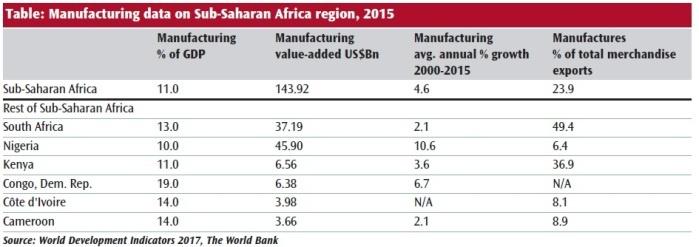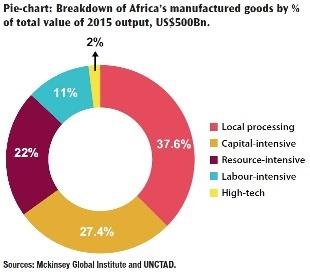The manufacturing sector could boost huge economic growth for the continent but its share of GDP has not moved from around 11 per cent over the last 10 years. Economic correspondent Moin Siddiqi investigates
In today’s sophisticated global economy, Africa remains a weak link. The region could become an emerging manufacturing hub through optimal development of natural and human resources and increased technological transfers. Li Yong, director-general of the United Nations Industrial Development Organisation, said: “Africa is by no means destined to lag behind the rest of the world economy. But to fulfil its economic potential, Africa must industrialise.”
Manufacturing is a major untapped growth opportunity in Africa, but the sector’s share in gross domestic product (GDP) across the continent has stagnated at 11 per cent over the past decade, compared to 23 per cent in East Asia & Pacific, according to the most recent World Bank data. In 2015, Africa’s manufacturing output was worth US$500bn, of which five countries (Egypt, Morocco, Nigeria, South Africa, and Tunisia) comprised the bulk of total capacity. Seventy per cent of production was consumed in the country of manufacture; tenth and one-fifth, respectively, were traded within Africa and exported outside Africa, according to Mckinsey Global Institute (MGI).
Five sub-sectors of manufactured categories are: Capital-intensive; e.g chemicals, transportation equipment. Labour-intensive; e.g textiles/apparel. Resource-intensive; e.g wood products, paper and pulp. Local processing: e.g rubber, plastics, fabricated metals, food. High-tech; Computers and office machinery.
Lagging global competitors
Africa’s share of global manufacturing exports has also stagnated at a paltry one per cent since 2000. In comparison, the World Bank reported China expanded its share of global exports from 4.7 per cent in 2000 to 18.8 per cent in 2015. Other Asian countries; Bangladesh and Vietnam, too, achieved rapid growth in manufacturing exports by matching low labour costs with active steps to attract investment, develop skills, and greater access to global markets through trade agreements.
African import products can be manufactured more cheaply within the region. One third of food, beverages, and other processed goods consumed in Africa are imported; while Southeast Asian and Latin American countries import approximately 20 and 10 per cent, respectively, of such goods. Similarly, about two-thirds of Africa’s supply of capital-intensive items (mainly automobiles and machinery) are imported, which is twice the level for Latin America.
Despite abundant local raw materials, Africa still imports a large share of manufactured products, including cement and refined petroleum. In 2015, 49 refineries were operating across the region, but little new capacity is expected on stream over the medium-term, reflecting the challenge of building competitive refineries in Africa. Regional refining capacity remains low at 2.1mn-bpd, while BP reported Africa’s total 2016 oil production at 7.89mn-bpd.
Promising fundamentals
The continent is well-placed to industrialise, driven by the following factors:
• Massive natural resource endowments, which can be used as raw materials for heavy and light industries. Africa boasts the largest unexplored resource basins on Earth with 80-90, 50, and 40 per cent, respectively, of chromium, manganese, vanadium and platinum; diamonds; and gold, as well as 60 per cent of world’s uncultivated, arable cropland (approximately 600mn hectares). It also holds 7.5 per cent of global oil reserves and huge stranded natural gas resources.
• Fairly inexpensive labour and favourable demographics (about three-quarters of Africa’s population is aged under 35).Hence, it will soon have the world’s biggest workforce of 1.1bn by 2034, according to MGI analysis. These demographic trends offer an opportunity for vocational training and skill development – a prerequisite for building industrial value chains. Unit labour costs and wages are low compared to other regions.
• Africa also benefits from an educated diaspora.
• Africa’s stock of housing, commercial buildings and infrastructure is expanding – in tandem with rapid urbanisation – thereby creating demand for construction materials such as cement, metals, and wood.
High-potential sectors
Africa’s manufacturing output could double within a decade reaching the US$1trn mark by 2025, reckons MGI. Three-quarters of output expansion could derive from meeting growing domestic consumer and business demand, reducing the volume of goods that is imported. The rest could derive from boosting exports. Kenya, Ethiopia, Tanzania, Rwanda. Ghana, Senegal and Mauritius are expected to undergo some degree of industrialisation, along with Nigeria.
The largest opportunity forincreasing manufacturing value added lies in the capital-intensive category, like machinery/transport equipment, followed by agri-food value chain. Resource-intensive manufacturing (cement and petroleum products) and labour intensive goods (such as textiles/clothing) are smaller but still significant outlets for manufacturers to service both local and regional markets. As Africa’s business sector expands, demands for inputs such as machinery/ equipment and fuels/chemicals are increasing fast.
That makes the manufacturing of capital-intensive innovations a profitable sub-sector, however, that opportunity is mostly confined to those with established manufacturing hubs (Egypt, South Africa and Morocco). Nigeria has capacities in petrochemicals and fuels, Kenya in machinery and auto spare-parts, Botswana in diamond cutting, Zambia in metal processing, Ghana in gold refineries and aluminium smelting and Cameroon and Sierra Leone in steel-making underpinned by iron ore reserves. Labour-intensive manufacturing can integrate more African countries into global supply chains. But regional share of global labour intensive exports (US$1.6trn in 2014) was one per cent, well below 35 per cent share of global total for China in this category.
Industrial development strategies
The shortcomings in infrastructure, especially power supply and transport logistics, low labour productivity, still high trade barriers and lack of economies of scale constitute major barriers to industrialisation. Assembly-line operations are attracted by the presence of cluster industrial parks and special economic zones where investors receive fiscal incentives. Ethiopia plans to invest US$10bn over 10 years in export hubs to house textile, leather and agro-processing firms.
Further trade liberalisation and a supportive environment for manufacturers (including access to credit) can make Africa more competitive in global and regional value-chains. Lower tariff and non-traffic barriers will help firms reliant on imported intermediate inputs/machinery to export manufactured goods. To address the scale issue, three Regional Economic Communities in Africa representing 26 countries have launched the Tripartite Free Trade Area (TFTA) to provide an integrated, larger market for manufacturers.
Most African manufacturers need business administration courses to upgrade their productions and acquire better knowledge of the global marketplace. An educated workforce is crucial for exportoriented activities. “Investment in technical and vocational training programmes should complement investment in basic education to enhance specific skill-sets related to individual industries and value chains,” advises African Development Bank.
The African continent given its competitive edge in natural resources is not industrialising to its full potential. Foreign manufacturers boast high market shares in categories that could be produced more cheaply in Africa for both local and regional markets.
Presently, manufacturing sector serves a fraction of fast-growing domestic demand. However, industrialisation is crucial for job creation, export diversification, and diverting resources from less productive activities to newer ones, raising overall productivity, thereby leading to ‘structural transformation’ of the region.
First appeared in African Review in August 2017.








